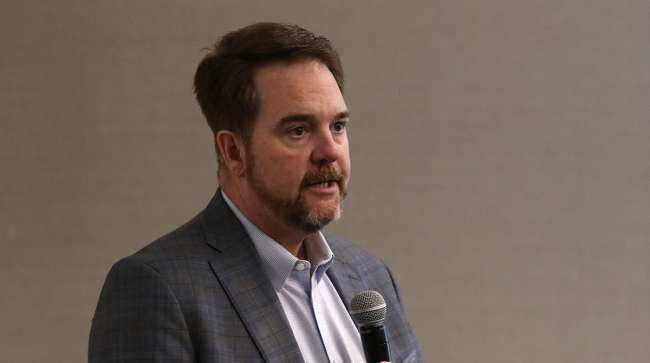Senior Reporter
Recruiting Leaders Say Demand for Truck Drivers Still Strong

[Stay on top of transportation news: Get TTNews in your inbox.]
NASHVILLE, Tenn. — Most companies attending the Recruitment & Retention Conference say they have held on to their human resource professionals as trucking industry recruiters endure the freight recession.
Experts at the event, sponsored by Conversion Interactive Agency, say they are maintaining this course of action with the anticipation more truck drivers will be needed once freight returns to higher levels.
“It’s been an interesting year, a real roller coaster,” Steve Sichterman, Conversion’s vice president of client services, told Transport Topics. “We’re seeing a lot less demand for drivers, but we’re still seeing fleets hiring drivers at a pretty good pace, but they are still struggling in many markets to find drivers.”
The companies say they decided to maintain recruiting staffing levels because of constant attrition in the industry, especially with an older workforce. Many fleets say they are focusing much of their HR efforts on retention.

Ketchum
“The biggest challenge in recruiting is understanding, including everyone in operations and other departments, that even though freight is low and the volumes are not as high as they were used to, don’t pump the brakes on recruiting,” said Erin Ketchum, Cowan Systems vice president of driver recruiting and retention. “Keep a steady flow of applicants and drivers coming through because once that freight comes back, everyone is going to be screaming for drivers. The competition is going to become fierce.”
Tim Norlin, Roehl Transport’s vice president of driver employment, said, “We’re still busy at Roehl Transport, but I have heard from some of my peers that many companies have cut their budgets and laid off people because they do not need as many drivers.
“But we decided long ago to … be ready when things turn around. Things are turning around. We are seeing glimpses of hope in freight in some markets, not all of them, but it’s a good sign.”

Norlin
Norlin was named the 2020 Transport Topics Recruiting Professional of the Year.
Attendees said that truck drivers’ salaries continue to rise but, according to a new report from Conversion and Nashville-based recruiting company Professional Driver Agency, not to the levels during the height of the pandemic when drivers often saw multiple wage increases. That was because freight volumes were at record levels, and both contract and spot rates soared.
Sichterman said average weekly pay is $1,740 a week, down from $1,780 a year ago. But at $90,480 a year at the end of 2023, that is more than $10,000 a year higher than in 2022, when pay was $80,042 annually.
We recently released our 2023 Annual Report in collaboration with PDA. Together, we've meticulously collected and analyzed data throughout the year to bring you this invaluable resource.
Download the report today! https://t.co/DMI1VpaESJ pic.twitter.com/jwRTmDahl0 — Conversion Interactive Agency (@ConversionIA) February 20, 2024
“As [2023] progressed, it became increasingly evident that the freight recession exerted a significant influence on driver paychecks, further exacerbating existing challenges in the industry,” Conversion-PDA report said. “The resulting uncertainty underscored the importance of fostering resilience and adaptability among carriers as they navigated through turbulent market conditions.”
The study also said companies are not reducing pay for existing drivers, many of whom stuck with their carriers during the pandemic, and that cutting wages would dramatically impact driver turnover. However, starting wages for new drivers generally are lower.
Van drivers are still the highest paid in the industry, averaging $1,815 per week or $94,380 annually. Sichterman and other professionals said companies with solid recruiting departments realize that retaining drivers is a financial bottom-line issue, and the average cost to replace a driver can easily exceed $10,000.

Dismuke
“One of the most important things is making a good first impression on that driver,” PDA Vice President of Operations Scott Dismuke said. “The worst thing a company can do is invest all of this money to bring a driver in, and then put them in a truck, right out of orientation, and they go to start the truck, and it’s dead, a tire is flat, a check-engine light is on, and there are fast-food wrappers inside from the previous driver.”
Sichterman emphasized, “Drivers want to be home more. They don’t want to give up money, and the fleets that are winning now are figuring out ways to make it work, whether it’s home once a week or multiple times a week, but the days of being out two or three weeks are in the past.”
American Trucking Associations estimates the average age of professional truck drivers is 46, and many who enter the industry begin their careers at age 35.
Industry recruiting advocate Lindsey Trent, co-founder and president of Next Generation in Trucking Association, which seeks to bring more young people into the industry and develop a more diverse workforce, told delegates that for trucking to thrive in the years ahead, attracting young people will be critical.
“We want to ensure trucking is being represented,” she said. “Young people need to see a career path and where it can lead in trucking. There are many options.”
Want more news? Listen to today's daily briefing below or go here for more info:




